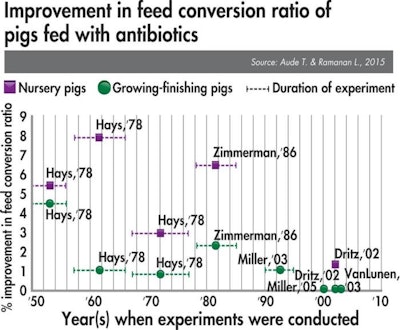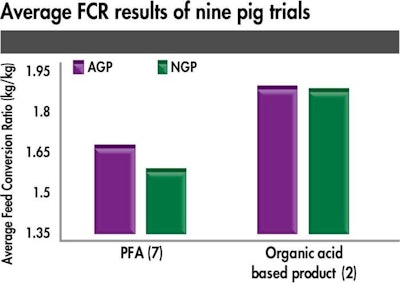
Regional differences reveal countervailing trends in antibiotic use in livestock and a strong future for the next generation of natural growth promoters.
In many countries, sub-therapeutic usage of antibiotic growth promoters (AGPs) is still widespread. Even though it is known that only part of the resistance problem results from antibiotic use in livestock, there are several initiatives to reduce the number of available antibiotics for growth promotion. According to the Netherlands-based Organization for Economic Co-operation and Development‘s (OECD) Trade and Agriculture Directive (TAD), the livestock sector’s consumption of antimicrobials is projected to rise by 67 percent between 2010 and 2030, reaching 105,600 metric tons annually.
Meanwhile, the sales of natural growth promoters should rise by at least 120 percent over the same period according to Biomin's calculations, albeit from a different base.
China and the United States account for nearly half of current antibiotic usage — a higher relative share of the global total compared to their weight in terms of feed production (see table, Distribution of total feed production and antibiotic usage). Yet, recent developments in each country reflect a move towards antibiotic use reduction.

The United States and China account for nearly half of antibiotic use in livestock globally. | Trade and Agriculture Directorate Committee for Agriculture et al.
Antibiotic usage: China vs. United States
Though they are currently the top users of antimicrobials, both China and the United States are taking measures to reduce their use of antibiotics in livestock production.
While China’s antimicrobial consumption is expected to grow in the coming decades, China has taken recent initiatives to limit antibiotic usage in animal production. Since the end of 2015, the production of lomefloxacin, pefloxacin, norfloxacin and ofloxacin for food animals was stopped, though their sales are still possible until the end 2016.
According to the Food and Drug Administration (FDA), U.S. antimicrobial usage increased 17 percent (from 12,587 to 14,788 metric tons) between 2009 and 2013. Intensive swine, poultry and feedlot cattle systems account for a majority of this consumption, with only limited quantities used in dairy and sheep. A full 95 percent of antibiotics were administered via feed (74 percent) or water (21 percent).
The growing demand for antibiotic-free beef, pork and chicken has prompted a number of high-profile food companies to further reduce or eliminate antibiotics from animal feed. Suppliers have noted the shifting demand and followed suit.
In addition, the U.S. FDA has encouraged producers to remove AGPs from livestock production. Some states have also taken action. In October 2015, California passed a measure banning the use of AGPs from January 2018 onwards.
Brakes on antibiotic usage
At least 32 countries have imposed a nationwide ban on antimicrobial growth promoters and 35 have a veterinary prescription requirement. In some areas, efforts, such as the European Union’s 2006 ban on the use of antibiotics as growth promoters in animal feed, led to a decline in sales.
According to European Medicines Agency (EMA), antibiotic consumption by food-producing animals across 25 European countries fell by 8 percent between 2011 and 2013.
Furthermore, scientific research suggests that the farm-level benefits have peaked. A meta-analysis of more than 1,000 swine trials between 1950 and 1985 did show average daily gain (ADG) and feed conversion ratio (FCR) improvements of 16.4 percent and 6.9 percent, respectively, in rearing pigs.
A new study corroborates these findings, but reveals that since 2000, in-feed antibiotics elicit only minor responses in pig performance indicators through different production stages. The authors suggest several possible explanations. First, AGPs may have a reduced impact when animal nutrition, hygiene, genetics and health status of the animals are optimal. Second, resistance to antibiotics may play a role in diminishing the effectiveness of AGPs. This coincides with an increase in recommended dosage levels of sub-therapeutic antibiotics over the past decades.

In contrast to the findings of experiments in the past, in-feed antibiotics have elicited only minor responses in pig performance indicators since 2000. | Aude T. & Ramanan L.
New ways to promote growth
Replacing AGPs will rely upon a holistic approach to improve animal health status and performance through better management, biosecurity measures, vaccination programs, diagnostics and feeding strategy.
Since feed costs account for a significant part of total production costs, feeding strategy is a crucial point. Organic acids, phytogenics, probiotics and prebiotics have all been identified as potential in-feed antibiotic replacements.
Natural growth promoters’ (NGPs) mode of action differs considerably from antibiotics. While phytogenic feed additives (PFAs or botanicals) tend to improve digestion and an animal’s anti-inflammatory and anti-oxidative status, organic acid-based products have a clearer antimicrobial effect that supports feed and water hygiene and the control of gram-negative bacteria. For example, probiotics, or direct-fed microbials, serve to reinforce a healthy gut microbiota.
All of these categories of feed additives are expected to grow more quickly than in-feed antibiotics in the coming years.
Comparable or better results
Significant effort has been paid to identifying which additives will replace AGPs. In general, a replacement should perform roughly equally as well under practical conditions in order to gain acceptance.
Looking across nine swine trials performed in various countries worldwide and testing both AGPs and NGPs (phytogenics or organic acid-based products) at a variety of production stages, each NGP group performed better on average in terms of FCR and ADG compared to the AGP group (Figures 2 and 3). This improvement accompanies better gut health and fewer intestinal disorders.

Natural growth promoters (NGP) perform at or better than antibiotic growth promoters (AGP) in terms of feed conversion ratios (FCR). | BIOMIN
In the above trials, both AGP and NGP groups performed better than control groups. In seven trials of antibiotics and phytogenic feed additives, PFAs delivered a 5.47 percent improvement in FCR compared to AGPs. In two trials of antibiotics and organic acid-based products, acidifiers offered just a one-half percent improvement in FCR.
This suggests that NGPs are appropriately suited to replace AGPs in terms of feed efficiency. Both antibiotics and certain phytogenics reduce inflammation within animals, generating energy savings that can be used for growth. Acidifiers work differently in that they contribute to feed and water hygiene and decrease the overall pathogen load in the gastrointestinal tract. FCR improvement matters considerably since feed costs account for around 70 percent of total swine production costs. Higher efficiency — meaning a lower FCR — means better profitability. Improving the FCR from 2.75 to 2.70 of weaner to finisher (8-110 kg) stages means around 5 kg less feed per pig, which reflects 5 metric tons feed savings per 1,000 pigs produced.

Natural growth promoters (NGP) deliver higher average daily gain than antibiotic growth promoters (AGP). | BIOMIN
In seven trials of antibiotics and phytogenic feed additives, pigs receiving the PFA had a 6 percent higher daily gain on average compared to those receiving AGPs. In two trials of antibiotics and organic acid-based products, pigs receiving acidifiers had a 10.8 percent higher daily gain on average compared to those receiving AGPs. Improvement of average daily gain (ADG) can positively influence the final weight of the animals and number of rotations. For instance, an ADG improvement in growing-finishing phase from 900 to 910 grams can result around +0.9kg extra weight for finishers at sale. The above trials indicate that NGPs can also be considered an appealing tool to improve performance parameters.
Identifying the right tool
These results suggest that performance can be maintained with natural growth promoters and that these can be considered an important tool in antibiotic reduction strategies.
The aim of NGPs should always focus on disease prevention, not treatment. Species, production phase, farm conditions, product dosage and ROI considerations all influence the choice of feed additive.
Furthermore, combinations of additives have been demonstrated to work successfully in particular situations to achieve specific objectives or to counter challenges such as mycotoxins or pathogenic bacteria. This means that organic acid-based products and phytogenic feed additives may each play a role in future production as part of a tailor-made solution to help producers achieve animal health and performance goals.
References available upon request.
Read more:
Antibiotic resistance not solved by livestock curbs alone, www.WattAgNet.com/articles/25090















